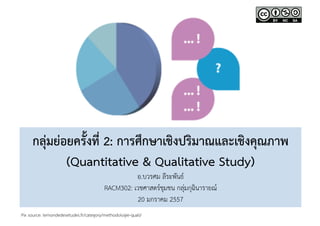Quanti & Quali study 2014.1.20
- 1. กลุ่มย่อยครั้งที่ 2: การศึกษาเชิงปริมาณและเชิงคุณภาพ (Quantitative & Qualitative Study)  อ.บวรศม ลีระพันธ์  RACM302: เวชศาสตร์ชุมชน กลุ่มกุฉินารายณ์  20 มกราคม 2557  Pix source: lemondedesetudes.fr/category/methodologie-quali/ 
- 2. Outline  1)  2)  3)  4)  5)  6)  7)  8)  9)  10)  การทำงานเป็นทีม (Teamwork)  ปัญหาสุขภาพในชุมชน (Health problems in the community)  การศึกษาวิจัยเชิงปริมาณและเชิงคุณภาพ (Quantitative & Qualitative study)   การทำงานภาคสนาม (Fieldwork)   การเตรียมเครื่องมือศึกษาชุมชน (Preparation of tools for community study) I, II  การทดสอบเครื่องมือศึกษาชุมชน (Testing tools for community study)  การแลกเปลี่ยนประสบการณ์เรียนรู้ (Sharing experiences & lessons learned)**   การวิเคราะห์ข้อมูลที่ได้จากการศึกษาชุมชน (Data analysis) I, II  การนำเสนองานอย่างมืออาชีพ (Preparing professional oral & poster presentation)  การสรุปบทเรียน (Wrap-up)  Pix source: online.wsj.com 
- 3. Format  Discussion, Q&A  F/U  Mini-lecture  Pix source: online.wsj.com  To-do list  Wrap-up 
- 4. Outline  •  ปรัชญาการเรียนรู้ (philosophy of science)  •  การศึกษาเชิงปริมาณ (quantitative study)  •  การศึกษาเชิงคุณภาพ (qualitative study)  •  ข้อบ่งชี้และข้อจำกัด (qualifiers and constraints)  Pix source: online.wsj.com 
- 5. Bronzino's Portrait of Cosimo I de’ Medici (1545)  
- 6. Rembrandt Harmenszoon van Rijn’s Familienporträt (1663-1668)  
- 8. Claude Monet’s Le Parlement de Londres  
- 9. Still Life: Vase with Twelve Sunflowers (1888); The Starry Night (1889) 
- 10. Three Approaches  Positivism  Critical Realism  Relativism/ Interpretivism/Social Constructionism  What types of questions asked about “situation/ intervention (X)”?  Does “X” work?   In reality of “X”, How does Is “X” cost-effective?  what components of stakeholders and X do works for understand “X”?  whom under which condition?  Related disciplinary perspectives  Clinical Medicine, Epidemiology, Welfare Economics  Policy Analysis, Organizational Studies  Anthropology, Sociology  Key Approaches & Methods  Deduction (อนุมาน, Hypothesis driven)  Theory testing and building  Induction (อุปมาน, inference of general laws from instances) 
- 11. Three Approaches  Positivism  Study tools  Critical Realism  Relativism/Interpretivism/ Social Constructionism  •  Measurements through survey, use of archival and other data records  •  Statistical analysis  •  Qualitative data analysis (through semi-structured interview and rigid interviewing procedures)  •  Multiple data   (review of documents, range of interviewing methods, observation)        •  Qualitative data analysis   (through  in-depth interviewing, focus-group interviewing, documentary review, participant observation,  life histories) 
- 12. Theory U  Source: Senge, P., Scharmer, C.O., Jaworski, J. & Flowers, B.S. (2004). Presence- Exploring Profound Change in People, Organizations and Society.    
- 13. Going Deepeer  •  Multiple levels of how we can learn from the fieldwork:  – Downloading: To test our knowledge e.g. test hypotheses  – Observing (using “open mind”): To understand new knowledge e.g. why and how do people think or behave in a certain way?  – Sensing (using “open heart”): To empathize people we met and create our own insight/knowledge  – Presencing (using “open will”) 
- 14. Going Deepeer  1.  Know “how to ask”  2.  Need skills to identify “emerging theme” 
- 15. Q & A  Pix source: online.wsj.com 















